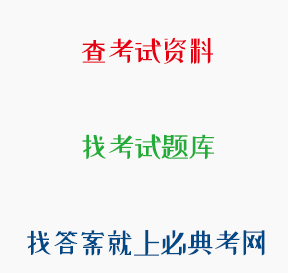正确答案: B
1945年《对目前时局的宣言》
题目:针对蒋介石“内战、独裁、分裂”的阴谋,中国共产党明确提出了“和平、民主、团结,,三大口号,以代替过去提出的“抗战、团结、进步”三大口号。这一.口号来源于
解析:为建立新中国而奋斗,这是中国人民的根本利益之所在。中国共产党希望通过和平的途径对中国进行政治社会的改革,逐步向新中国这个目标迈进。1945年8月25日,中共中央发表经政治局扩大会议讨论通过的《对目前时局的宣言》,明确提出党的方针是:“在‘和平’、‘民主’、‘团结’的基础上,实现全国的统一,建设独立自由与富强的新中国。”这是中共审时度势,顺应时代的要求,充分表达全国人民的迫切愿望和利益的方针。中共中央派毛泽东、周恩来、王若飞为代表,即赴重庆与国民党方面进行和平谈判,故B正确。
查看原题 查看所有试题
学习资料的答案和解析:
[单选题]某资本家投资100万元,每次投资所获得的利润为25万元,假定其资本有机构成为4:1,那么该资本家每次投资所实现的剩余价值率为( )
125%
解析:本题考点:剩余价值率。 该题是考查政治经济学中的剩余价值率。剩余价值率m‘=m,利润与剩余价值在量上是一样的,都是25万元,资本有机构成为c:v=4:1,全部预付资本c+v为100万元,所以可变资本v为20万元,因此剩余价值率m’=25/20=125%,D为正确答案。
[单选题]在当代中国。坚持发展是硬道理的本质要求是坚持科学发展.科学发展观是我国经济社会发展的重要指导方针。是发展中国特色社会主义必须坚持和贯彻的重大战略思想,是党必须长期坚持的指导思想。提出科学发展观的现实基础是
新世纪新阶段的阶段性特征
解析:科学发展观,是立足社会主义初级阶段基本国情,深入分析我国发展的阶段性特征、总结我国发展实践、准确把握世界发展趋势、借鉴国外发展经验,适应新的发展要求提出来的。我国社会主义初级阶段的基本国情是提出科学发展观的根本依据。新世纪新阶段的阶段性特征是提出科学发展观的现实基础。当代世界的发展实践和发展理念是提出科学发展观的重要借鉴。故C正确。D是邓小平理论形成的历J吏依据。
[多选题]坚持和完善社会主义初级阶段基本经济制度,必须毫不动摇巩固和发展公有制经济,必须毫不动摇鼓励、支持、引导非公有制经济发展。这是因为,公有制经济和非公有制经济都是我国
经济社会发展的重要基础
社会主义市场经济的重要组成部分
解析:AB(经济社会发展的重要基础;社会主义市场经济的重要组成部分)
[单选题]正确答案是_______.
[单选题]What prompted the chancellor to develop his scheme?
A passion to ensure fairness for taxpayers.
解析:是什么促使总理制定他的计划?希望所有的人有更美好的生活。
[单选题]请在第__5__处填上正确答案。
wellbeing
[单选题]根据以下资料,回答{TSE}题。In the 2006 film version of The Devil Wears Prada, Miranda Priestly, played by Meryl Streep, scold her unattractive assistant for imagining that high fashion doesn’t affect her.Priestly explains how the deep blue color of the assistant’s sweater descended over the years from fashion shows to department stores and to the bargain bin in which the poor girl doubtless found her garment.This top-down conception of the fashion business couldn’t be more out of date or at odds with feverish world described in Overdressed, Elizabeth Cline’s three-year indictment of “fast fashion”.In the last decades or so, advances in technology have allowed mass-market labels such as Zara, H&M, and Uniqlo to react to trends more quickly and anticipate demand more precisely.Quckier turnrounds mean less wasted inventory, more frequent releases, and more profit.Those labels encourage style-conscious consumers to see clothes as disposal—— meant to last only a wash or two, although they don’t advertise that——and to renew their wardrobe every few weeks.By offering on-trend items at dirt-cheap prices, Cline argues, these brands have hijacked fashion cycles, shaking all industry long accustomed to a seasonal pace.The victims of this revolution, of course, are not limited to designers.For H&M to offer a 5.95 knit miniskirt in all its 2300-plus stores around the world, it must rely on low-wage, overseas labor, order in volumes that strain natural resources, and use massive amount of harmful chemicals.Overdressed is the fashion world’s answer to consumer activist bestsellers like Michael Pollan’s The Omnivore’s Dilemma.Mass-produced clothing, like fast food, fills a hunger and need, yet is non-durable, and wasteful,” Cline argues, Americans, she finds, buy roughly 20 billion garments a year——about 64 items per person——and no matter how much they give away, this excess leads to waste.Towards the end of Overdressed, Cline introduced her ideal, a Brooklyn woman named SKB, who, since 2008 has make all of her own clothes——and beautifully.But as Cline is the first to note, it took Beaumont decades to perfect her craft; her example, can’t be knocked off.Though several fast-fashion companies have made efforts to curb their impact on labor and the environment——including H&M, with its green Conscious Collection Line——Cline believes lasting-change can only be effected by the customer.She exhibits the idealism common to many advocates of sustainability, be it in food or in energy.Vanity is a constant; people will only start shopping more sustainably when they can’t afford to it.{TS}Priestly criticizes her assistant for her
insensitivity to fashion.
[单选题]What is the subject of the text?
根据以下资料,回答下面的题目。In the 2006 film version of The Devil Wears Prada, Miranda Priestly, played by Meryl Streep, scold her unattractive assistant for imagining that high fashion doesn’t affect her.Priestly explains how the deep blue color of the assistant’s sweater descended over the years from fashion shows to department stores and to the bargain bin in which the poor girl doubtless found her garment.This top-down conception of the fashion business couldn’t be more out of date or at odds with feverish world described in Overdressed, Elizabeth Cline’s three-year indictment of “fast fashion”.In the last decades or so, advances in technology have allowed mass-market labels such as Zara, H&M, and Uniqlo to react to trends more quickly and anticipate demand more precisely.Quckier turnrounds mean less wasted inventory, more frequent releases, and more profit.Those labels encourage style-conscious consumers to see clothes as disposal—— meant to last only a wash or two, although they don’t advertise that——and to renew their wardrobe every few weeks.By offering on-trend items at dirt-cheap prices, Cline argues, these brands have hijacked fashion cycles, shaking all industry long accustomed to a seasonal pace.The victims of this revolution, of course, are not limited to designers.For H&M to offer a 5.95 knit miniskirt in all its 2300-plus stores around the world, it must rely on low-wage, overseas labor, order in volumes that strain natural resources, and use massive amount of harmful chemicals.Overdressed is the fashion world’s answer to consumer activist bestsellers like Michael Pollan’s The Omnivore’s Dilemma.Mass-produced clothing, like fast food, fills a hunger and need, yet is non-durable, and wasteful,” Cline argues, Americans, she finds, buy roughly 20 billion garments a year——about 64 items per person——and no matter how much they give away, this excess leads to waste.Towards the end of Overdressed, Cline introduced her ideal, a Brooklyn woman named SKB, who, since 2008 has make all of her own clothes——and beautifully.But as Cline is the first to note, it took Beaumont decades to perfect her craft; her example, can’t be knocked off.Though several fast-fashion companies have made efforts to curb their impact on labor and the environment——including H&M, with its green Conscious Collection Line——Cline believes lasting-change can only be effected by the customer.She exhibits the idealism common to many advocates of sustainability, be it in food or in energy.Vanity is a constant; people will only start shopping more sustainably when they can’t afford to it.Priestly criticizes her assistant for her
Exposure of a mass-market secret.

 川公网安备 51012202001360号
川公网安备 51012202001360号